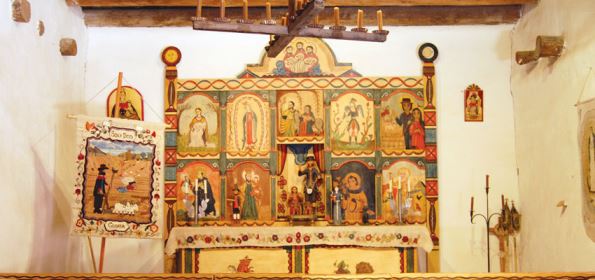History is alive at this Spanish colonial haven near Santa Fe, New Mexico.
By Marion Amberg
May 2016
When you pass the enormous wooden gates at El Rancho de las Golondrinas — the Ranch of the Swallows — and enter the 200-acre living-history museum 15 miles southwest of Santa Fe, New Mexico, you’re following in the wagon tracks of countless travelers before you. Settled in the early 1700s, Las Golondrinas was a paraje (stopping place) on the Camino Real, the “Royal Road” used by Spanish colonists journeying between Santa Fe and Mexico City. They stopped for supplies, to camp for the night, and to catch up on the news. Las Golondrinas was one of New Mexico’s first campgrounds!
Today Las Golondrinas is a paraje for tourists wanting to learn more about the Spanish colonial way of life. Depending upon the season, colonist re-enactors may be stomping grapes for wine, seeding or tilling the fields, stringing chiles, baking bread in the outdoor adobe ovens, tanning hides, or weaving blankets. If you’re looking for a bit of gossip about the colonists, keep your ears open!
The tour begins at the Golondrinas Placita (Little Plaza of the Swallows), a defensive square of adobe rooms with a watchtower erected around a small plaza to protect the colonists from attack. Furnished as though the owners might return any day, the rooms are filled with colonial ingenuity. “The colonists didn’t waste anything, not even space,” explained docent Susan Maslar. “What they didn’t have, they invented.”
Above the kitchen fireplace is the shepherd’s bed, a built-in adobe bunk that was heated by the fire below. A hollowed-out log served as a grain bin. The shears above the doorway were a symbol of good luck. In the weaving room, a malacate — a long, thin spindle crafted from a sturdy stick — was used to turn wool into yarn. Homegrown vegetables were stored in a root cellar, but one vegetable had a dual purpose.
“If a young lady declined a man’s offer of marriage, she gave him a squash!” our guide said. She thus “squashed” his proposal.
There were no idle hands on this ranch. Men fashioned iron into farm tools or butchered animals while boys stood sentinel in the watchtower, keeping an eye out for raiding native tribes or approaching convoys. Women gathered wild herbs for medicines and hand-ground corn into flour. Girls applied a mixture of animal blood and clay to the dirt floors to harden and smooth them. They also made dresses for their homemade dolls.
Today, an American Girl doll named Josefina represents delightful tales of growing up at Las Golondrinas in the 1820s. These are told in a series of books written about the fictional character. The ranch provides a special 1½ hour tour and video centered around the Josefina stories; ask for details if you’re interested.
The Spanish colonists were devout Catholics, and their faith shines at Las Golondrinas. Paintings on wood panels and hand-carved statues of saints adorn rooms and the chapel. The chapel and its colorful altar screen are dedicated to San Ysidro (Saint Isidore the farmer), the beloved patron saint of farmers and ranchers. According to lore, while the saint was attending church, angels plowed his fields.
Like a real working ranch, Las Golondrinas invokes San Ysidro to bless the fields and livestock. During the Spring Festival, after a Mass in petition for a good harvest, a wooden statue of San Ysidro is carried in procession to his hilltop oratory overlooking the ranch. During the Harvest Festival, a Mass of thanksgiving for the bounty of the earth takes place, and a procession returns San Ysidro to the chapel for the winter months.
There’s much more to see at Las Golondrinas. Leaving the placita, follow your map to period buildings representing 18th- and 19th-century life in northern New Mexico. Visit a dye shed where yarn was dyed into countless colors; sorghum and flour mills; and a replica of a mountain village. The morada is a meetinghouse of the Penitentes, where members of this lay Catholic brotherhood gathered to do penance and commemorate the passion of Christ. If the Madrid House looks like a movie set, it is. Scenes from Butch and Sundance: The Early Days and other movies were filmed there. The staircase inside is legendary for going … nowhere!
“El Rancho de las Golondrinas is an oasis of Spanish culture and history,” said our guide. “Wherever you walk on this historic ranch, you’re stepping into the past, a past that shaped the American Southwest.” If you listen carefully, you can hear the echo of oxcarts and wagons arriving from Mexico City. There’s going to be a hot time in the old paraje tonight!
Let’s Go!
El Rancho de las Golondrinas
334 Los Pinos Road
Santa Fe, NM 87507
(505) 471-2261
www.golondrinas.org
El Rancho de las Golondrinas is open June 1 through October 2 this year. Hours are 10:00 a.m. to 4:00 p.m., Wednesday through Sunday. Guided tours are offered at 10:30 a.m. each day. If you miss the guided tour, you can still take your own self-guided one; just be sure to ask for a guidebook. Admission is $6 for adults, $4 for seniors and teens, and free for children 12 and under. Higher admission fees apply during special events, such as the Herb and Lavender Fair, the Santa Fe Wine Festival, the Viva Mexico! celebration, and the Harvest Festival. During the months of April, May, and October, the museum is open Monday through Friday for docent-led tours available only by calling in advance for a reservation.
The ranch has plenty of space for RV parking. From Santa Fe, take Interstate 25 south to Exit 276. Follow the brown “Las Golondrinas” signs about four miles to the museum.

